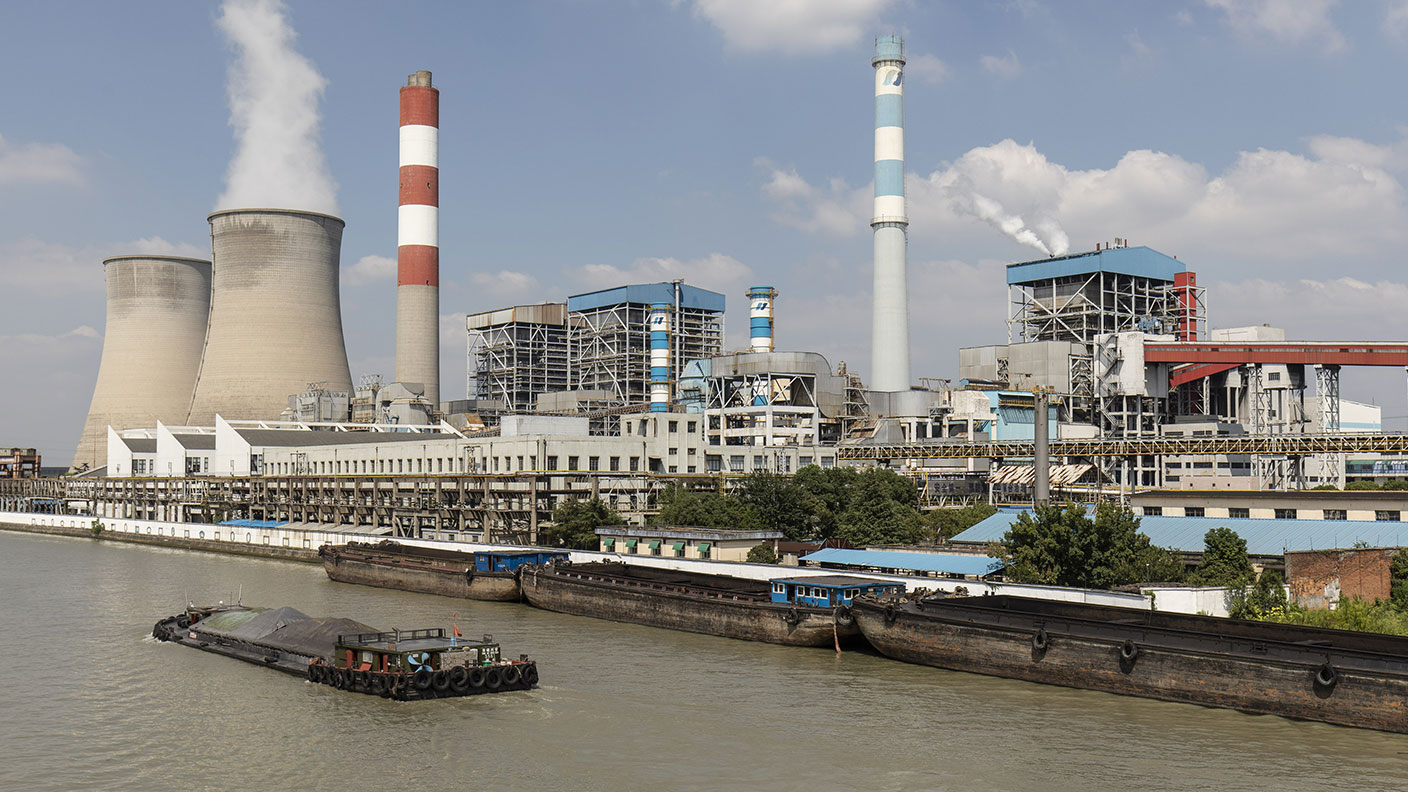China’s energy crunch could export inflation around the globe
As China suffers an energy crisis too, the odds of stagflation – slowing growth but rising prices – increase. John Stepek explains why and what that might mean for your portfolio.


Quick reminder: don’t forget to get your ticket for the virtual MoneyWeek Wealth Summit. Early bird prices are still available, but not for long – it promises to be an extremely timely event this year, given all the upheaval we’re seeing. We’ll be asking some of the smartest financial experts around to help guide us through it all. Book here now.
And conveniently enough, upheaval is what we’re talking about today.
Like most of the rest of the world, China has been trying to cut down on fossil fuel usage. China is heavily dependent on coal; it accounts for about 70% of its electricity generation.
MoneyWeek
Subscribe to MoneyWeek today and get your first six magazine issues absolutely FREE

Sign up to Money Morning
Don't miss the latest investment and personal finances news, market analysis, plus money-saving tips with our free twice-daily newsletter
Don't miss the latest investment and personal finances news, market analysis, plus money-saving tips with our free twice-daily newsletter
But coal is dirty in a very visible manner – pollution and smog always causes discontent. And with China hosting the Winter Olympics early next year, the country has an added incentive to clean up its act.
So it tells you that something has gone very awry when you hear that China is now telling coal miners to dig for all they’re worth, smog be damned.
China’s U-turn on coal sums up what’s gone wrong with the recovery
China’s state-owned miners have been commanded, reports Bloomberg, “to produce coal at full capacity for the rest of the year even if they exceed annual quota limits.”
Meanwhile the price of the muckiest type of coal – lignite from Indonesia – has hit a record level, more than quadrupling in price in the past year.
This is partly because China is still refusing to buy from Australia, but also because all of the energy companies have been ordered to secure whatever supplies they need for winter. “Blackouts will not be tolerated”, apparently.
That’s sent the price of liquefied natural gas (LNG) through the roof too. As one commodities analyst tells Bloomberg: “They will bid whatever it takes to win a bidding war”.
China’s actions show that, as of now, keeping the lights on is more important than keeping the skies clear. Little wonder: factories are already being shut down by blackouts, which meant that September saw the first drop in manufacturing activity since February 2020.
So what’s gone wrong? What’s going on in China is really just an exaggerated (and really quite important) version of what’s happening everywhere else. Surging demand is meeting restricted supply, and it’s all being made worse by governments jumping the gun when it comes to ideals of decarbonisation and energy transition.
Why supply has lagged demand so badly
Every country has its own variations on this theme, depending on where they get their energy from. But the underlying issue is similar across the entire world.
On a broad economic front, post-lockdown demand from consumers has rebounded more rapidly than producers of goods and services were prepared for.
This makes sense. If you’re running a widget factory and suddenly no one can buy your widgets, it makes sense to err on the side of caution, even if it seems likely that demand will rebound when the shutdown ends. In fact, you probably have to err on the side of caution because you’ll need to conserve cash.
So it was always likely that supply would lag demand once the lockdowns started to ease off. Hence the supply chain disruption (which is also made worse by the fact that while domestic economies have opened up to a great extent, the global economy – which relies on smooth cross-border movement – has not opened up to anywhere near the same extent).
This has all been exacerbated by another factor. On the energy front, producers cut back due to lack of demand. But they have the added disincentive of everyone talking about stranded assets and “net zero” and “peak oil demand” and all the rest of it.
It’s not very tempting to invest in extra capacity to meet demand if all opinion and policy points to your products being phased out in the long run. That makes for a tricky balancing act.
So we’re dealing with some big mismatches. In some ways, the world is acting as if we transitioned to net zero in 2020 when in fact, we just switched all the lights off for a short while.
Now that we’re switching them back on, we’ve realised that a “return to normal” also means a return to normal levels of energy consumption, and right now we don’t have a substitute for the dirty fuels that we’re so desperate to stop using.
Inflation is looking less and less transitory
What does all of this mean for investors?
A slowdown in the world’s second-largest economy is not good news. If Chinese factories are switched off, it means they’re not making stuff, which means the energy supply crunch will also morph into a goods supply crunch.
Overall, this means rising costs for companies. And that will almost certainly be passed onto consumers. But consumers aren’t going to take that sitting down either, because there’s a labour supply crunch, too. Which means they’ll be demanding higher wages. Which starts the whole merry-go-round off again.
This is already happening. In Germany, the FT reports, “increasing numbers of German workers are demanding higher pay amid rising inflation, with some going on strike”. For example, the country’s biggest union, IG Metall, is demanding a 4.5% pay rise, plus added pension benefits, for workers at one group of companies in southern Germany.
It’s a similar story in Australia. Capital Economics notes that “union officials’ inflation expectations have surged… A push by union officials to offset rising living costs coupled with severe labour shortages provide fertile ground for wage hikes in upcoming enterprise bargaining agreements.”
To be clear, I’m all for wage rises. A pendulum swing back to labour from capital has been overdue for some time and it’s at the heart of our political discontent. But as we’ve also pointed out on many occasions, this sort of shift would represent a huge change in the investment environment from the one most of us have lived through so far.
What does that mean for your portfolio? It means that if you haven’t given any thought to protecting your wealth from an environment of potentially weaker growth and relentlessly rising prices, then you probably need to.
The “death of the 60/40 portfolio” is one of many topics we’ll be discussing at the Wealth Summit. So book your ticket now.
Get the latest financial news, insights and expert analysis from our award-winning MoneyWeek team, to help you understand what really matters when it comes to your finances.
John Stepek is a senior reporter at Bloomberg News and a former editor of MoneyWeek magazine. He graduated from Strathclyde University with a degree in psychology in 1996 and has always been fascinated by the gap between the way the market works in theory and the way it works in practice, and by how our deep-rooted instincts work against our best interests as investors.
He started out in journalism by writing articles about the specific business challenges facing family firms. In 2003, he took a job on the finance desk of Teletext, where he spent two years covering the markets and breaking financial news.
His work has been published in Families in Business, Shares magazine, Spear's Magazine, The Sunday Times, and The Spectator among others. He has also appeared as an expert commentator on BBC Radio 4's Today programme, BBC Radio Scotland, Newsnight, Daily Politics and Bloomberg. His first book, on contrarian investing, The Sceptical Investor, was released in March 2019. You can follow John on Twitter at @john_stepek.
-
 Metals and AI power emerging markets
Metals and AI power emerging marketsThis year’s big emerging market winners have tended to offer exposure to one of 2025’s two winning trends – AI-focused tech and the global metals rally
-
 8 of the best houses for sale with beautiful fireplaces
8 of the best houses for sale with beautiful fireplacesThe best houses for sale with beautiful fireplaces – from a 15th-century cottage in Kent to a 17th-century palazzo in Oxfordshire
-
 UK wages grow at a record pace
UK wages grow at a record paceThe latest UK wages data will add pressure on the BoE to push interest rates even higher.
-
 Trapped in a time of zombie government
Trapped in a time of zombie governmentIt’s not just companies that are eking out an existence, says Max King. The state is in the twilight zone too.
-
 America is in deep denial over debt
America is in deep denial over debtThe downgrade in America’s credit rating was much criticised by the US government, says Alex Rankine. But was it a long time coming?
-
 UK economy avoids stagnation with surprise growth
UK economy avoids stagnation with surprise growthGross domestic product increased by 0.2% in the second quarter and by 0.5% in June
-
 Bank of England raises interest rates to 5.25%
Bank of England raises interest rates to 5.25%The Bank has hiked rates from 5% to 5.25%, marking the 14th increase in a row. We explain what it means for savers and homeowners - and whether more rate rises are on the horizon
-
 UK inflation remains at 8.7% ‒ what it means for your money
UK inflation remains at 8.7% ‒ what it means for your moneyInflation was unmoved at 8.7% in the 12 months to May. What does this ‘sticky’ rate of inflation mean for your money?
-
 Would a food price cap actually work?
Would a food price cap actually work?Analysis The government is discussing plans to cap the prices of essentials. But could this intervention do more harm than good?
-
 Is my pay keeping up with inflation?
Is my pay keeping up with inflation?Analysis High inflation means take home pay is being eroded in real terms. An online calculator reveals the pay rise you need to match the rising cost of living - and how much worse off you are without it.
